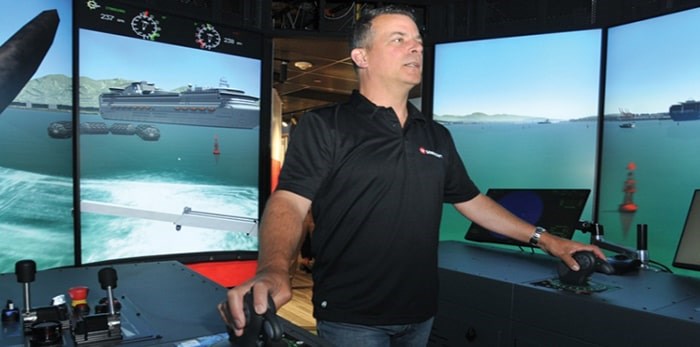Seaspan Marine Transportation is debuting its latest high-tech tactic to help tug masters safely and gingerly nudge 10,000-tonne ships up to Port of �鶹��ýӳ��docks.
 Master Tony Poole takes the helm inside Seaspan’s brand new tug simulator, a training tool that allows new masters to get hyper-realistic training experience. Photo: Paul McGrath, North Shore News
Master Tony Poole takes the helm inside Seaspan’s brand new tug simulator, a training tool that allows new masters to get hyper-realistic training experience. Photo: Paul McGrath, North Shore News
The shipping support arm of the North Vancouver-based company is now using a $1-million marine simulator facility, the first of its kind in North America.
“This new training program will ensure Seaspan mariners are the most highly trained mariners in North America,” said Bart Reynolds, president of Seaspan Marine, at the launch event held July 4.
“We see this as our contribution to the protection of the harbour and coastline and the welfare of our people.”
Inside the simulator is a mockup of a tug’s bridge. The tug master in-training stands in the middle of a dozen 86-inch, floor-to-ceiling screens giving an accurate 360-degree view of �鶹��ýӳ��Harbour.
For the launch, Seaspan set up a U-shaped course to let wannabe tug masters take the controls of the digital equivalent of the 441-tonne, 5,000-horsepower Seaspan Raven. It’s all just a simulation but try telling that to your stomach as the horizon tilts when the tug corners sharply.
“The best thing that we can have is for it to be extremely accurate and like the vessels we have, so that going from here to there is seamless as far as the operator is concerned,” said Sean Poole, director of vessel operations, gesturing from the simulator complex to the real life Raven docked outside.
“It’s theory and practical training coupled together.”
Trainers can introduce ocean swells, violent storms and buzzing helicopters, all of which will be seen, heard and felt inside the simulator, even though those scenarios are highly unlikely in real life.
“Most of that stuff doesn’t happen in �鶹��ýӳ��Harbour,” Poole said.
“When you can perform a job in the worst-case scenario, you can work backwards from that, and the normal day-to-day becomes pretty straightforward.”
https://youtu.be/rSZtHNOsW8Y
The simulator is part of a $5.5-million training program Seaspan is embarking on over the next five years in partnership with SeaWays Global. Beyond the usual classroom curriculum, trainees will receive 10 days of intensive simulation, followed by seven days aboard the real deal.
Even the current tug masters with decades of experience will be put through their paces on the simulator, Poole said.
Seaspan and its predecessor companies date back more than 130 years on Burrard Inlet, and the company has an impressive safety record they want to build on, said Seaspan Marine CEO Frank Butzelaar
“Never in our history have we ever had a loss of product or cargo into the water during any of our ship docking and escorting events. That’s not to say we have been completely accident or incident free. There have been the rare cases of damage either to a ship, to our tug or to both vessels. And that’s not acceptable. We wanted to find how we are going to go from an exemplary track record to a perfect track record going forward. This is that next step for us in our evolution,” he said.
The move has the praise of the �鶹��ýӳ��Fraser Port Authority. While there is much talk of the increased shipping traffic that would come with the twinning of the Trans Mountain pipeline, which is expected to increase overall traffic through the port by about 10 per cent, export terminals around Burrard Inlet and the Fraser River have been expanding.
In 2016, the port authority forecast its daily vessel calls would grow from about 3,160 per year (about nine per day) to 4,380 per year by 2026.
“As we start to step into that role as a major international gateway with traffic densities that are increasing … initiatives like this are so important,” said Peter Xotta vice-president of planning and operations for the �鶹��ýӳ��Fraser Port Authority.


